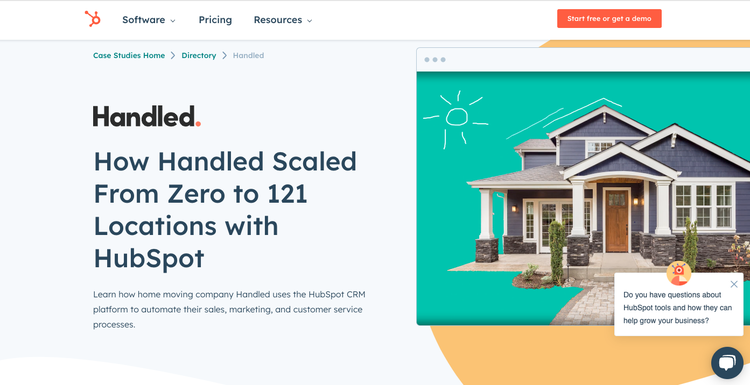Marketing case study 101 (plus tips, examples, and templates)
Learn how to create your own marketing case study to share with potential customers with this step-by-step guide.

Summary/Overview
If you’re familiar with content lines like, “See how our fancy new app saved Sarah 10 hours a week doing payroll,” you’ve encountered a marketing case study. That’s because case studies are one of the most powerful marketing tools, showcasing real-world applications and customer success stories that help build trust with potential customers.
More than 42% of marketers use case studies in their marketing strategy. Let’s face it — we love testimonials and reviews. People love hearing customer stories and experiences firsthand. In fact, 88% of consumers view reviews before making a purchase decision. Case studies work similarly by providing prospective customers with real-life stories demonstrating the brand’s success.
Case studies provide a more in-depth view of how your product solves an existing problem — something potential buyers can relate to and learn from.
In this article, we take a closer look at what marketing case studies are, why they’re important, and how you can use them to improve your content marketing efforts. You’ll also learn the key elements of a successful case study and how to turn a good case study into a great case study.
What is a marketing case study?
A case study is a narrative that documents a real-world situation or example. A marketing case study is a detailed examination and analysis of a specific strategy, initiative, or marketing campaign that a business has implemented. It’s intended to serve as an all-inclusive narrative that documents a real-world business situation and its outcome.
Marketing case studies are tools businesses use to showcase the effectiveness of a particular tool, technique, or service by using a real-world example. Companies often use case studies as sales collateral on websites, email marketing, social media, and other marketing materials. They provide readers with a firsthand look into how your product or service has helped someone else and demonstrate the value of your offering while building trust with potential customers.
Some common key components of a marketing case study include:
- Context: A case study begins by describing the business’s situation or problem. This often includes challenges, opportunities, or objectives.
- Strategy: An outline of the tactics or strategy utilized to address the business’s situation. This includes details such as the target audience, messaging, channels used, and other unique aspects of the approach.
- Implementation: Provide information about how the strategy was implemented, including timeline, resources, and budget.
- Results: This is arguably the most crucial part of a marketing case study. Present the results through data, metrics, and key performance indicators (KPIs) to demonstrate the impact of the strategy. The results section should highlight both qualitative and quantitative data.
- Challenges and Solutions: A great case study not only focuses on the successes but addresses any obstacles faced during the campaign. Make sure to address any challenges and how they were overcome or mitigated.
- Customer Feedback: Including testimonials or quotes from satisfied clients is a great way to add credibility and authenticity to a case study. Choose customer feedback that reinforces the positive outcomes of the strategy taken.
- Visuals: Compelling case studies include visuals such as graphs, charts, images, videos, and infographics to make the information presented more engaging and easier to understand.
- Analysis: An optional way to conclude a case study includes discussing key takeaways, insights, and lessons learned from a campaign.
Case studies can help you connect your product to the customer’s needs by providing a real world examples of success and encouraging conversions.
Benefits of marketing case studies
Some of the key benefits of using case studies in your marketing efforts include the following:
- Building trust and credibility. You build trust and credibility with potential clients or customers by demonstrating real world success stories. In-depth looks at how your products or services have helped other businesses or people achieve success can increase customer loyalty and encourage repeat business.
- Learn best practices. Learn from strategies employed in successful case studies and apply similar approaches to future campaigns.
- Enhancing sales and conversions. By highlighting the real world results your products or services have delivered, case studies can be a powerful tool for boosting sales. They can help demonstrate the value of your offering and persuade your target audience to make a purchase.
- Explain how your business generates results. Case studies are a compelling way to share key takeaways with your target audience and showcase your brand.
- Use them as content marketing material. Use case studies as content for marketing purposes on websites, social media, and beyond.
Case studies can help your business stand out and achieve success. By highlighting the real world results you’ve delivered, you can use case studies to boost sales, build customer loyalty, and compellingly showcase your business.
Tips on how to write an effective marketing case study
Are you ready to write a compelling case study? Get started with these tips.
Develop a clear and compelling headline
You have about 10 seconds to communicate your value proposition to keep customer attention. Whether you’re designing a new landing page or making a long-term plan for your brand’s content marketing strategy, the headline is the most crucial part.
A compelling title should capture readers’ attention and make them want to read more. To craft a compelling headline:
- Understand your audience: Before crafting a headline, ensure you know your target audience — what are their pain points, interests, and needs?
- Highlight the most significant result: Focus on the most impactful result achieved in the case study. What was the primary outcome of the strategy implemented?
- Keep it brief: Keep your headline concise and to the point. Try to keep your headline under 12 words.
- Use action words: Incorporate action verbs such as “achieved,” “transformed,” or “boosted” to convey a sense of accomplishment.
- Include data: Numbers make your headline more credible. For example, if the case study achieved a 75% increase in sales, include that in the headline.
- Emphasize benefits: Focus on the positive changes or advantages the implemented strategy brought to the client or business. Use these as selling points in your headline.
- Make it unique and memorable: Avoid generic phrases to make your headline stand out from the competition.
- Use keywords wisely: Incorporate relevant keywords that align with the case study and your target audience’s search interest to improve search engine visibility through search engine optimization (SEO).
- Consider subheadings: If you cannot fit all the necessary information in a headline, consider adding a subheading to provide additional context or details.
Here are some examples of clear and convincing case study headlines:
- “Achieving a 150% ROI: How [XYZ] Strategy Transformed a Startup”
- “How Optimized SEO Tactics Skyrocketed Sales by 80%”
- “Mastering Social Media: How [ABC] Brand Increased Engagement by 50%”
- “The Power of Personalization: How Tailored Content Quadrupled Conversions”
Write relatable content
Almost 90% of Gen Z and millennial shoppers prefer influencers who they consider relatable. Relatability is part of building trust and connection with your target audience.
When writing your case study, make content that resonates with readers and speaks to their pain points. The best marketing doesn’t just increase conversion rates — it also serves your customers’ needs. To write content that really resonates with your target audience, make sure to:
- Understand your audience: To successfully write relatable content, you first need to understand your target audience — their interests, pain points, and challenges. The more you know about your target audience, the better you can tailor your content to their needs.
- Identify pain points: As mentioned above, identify challenges your target audience may face. Make sure to highlight how the product or service in the case study can effectively address these pain points.
- Tell a story: Create a narrative that follows a standard story arc. Start with a relatable struggle that the customer or business faced and describe its associated emotions.
- Use real customer feedback: Incorporate quotes or testimonials from actual customers or clients. Including authentic voices makes the content more relatable to readers because they can see real people expressing their experiences.
- Use relatable language: Write in a tone to which your audience can relate. Only include overly technical terms if your target audience solely consists of experts who would understand them.
- Use social proof: Mention any recognitions, awards, or industry acknowledgments that may have been received by the customer or business in the case study.
- Encourage engagement: Urge readers to share their own challenges or experiences related to the subject matter of the case study. This is a great way to foster a sense of community.
Outline your strategies with corresponding statistics
Whether you’re showing off the results your marketing team achieved with a new strategy or explaining how your product has helped customers, data and research make it easier to back up claims.
Include relevant statistics in your case study to provide evidence of the effectiveness of your strategies, such as:
- Quantitative data: Use numerical data to quantify results.
- Qualitative data: Use qualitative data, such as customer testimonials, to back up numerical results.
- Comparisons: Compare the post-campaign results with the pre-campaign benchmarks to provide context for the data.
- Case study metrics: Include specific metrics relevant to your industry or campaign if applicable. For example, in e-commerce, common metrics could include customer acquisition cost, average order value, or cart abandonment rate.
By incorporating relatable outcomes — such as cost savings from new automation or customer responsiveness from your new social media marketing campaign — you can provide concrete evidence of how your product or service has helped others in similar situations.
Use multiple formats of representation
People love visuals. It doesn’t matter if it’s an infographic for digital marketing or a graph chart in print materials — we love to see our data and results represented in visuals that are easy to understand. Additionally, including multiple representation formats is a great way to increase accessibility and enhance clarity.
When making a case study, consider including various forms of representation, such as:
- Infographics: Use infographics to condense critical information into a visually appealing, easy-to-understand graphic. Infographics are highly sharable and can be used across marketing channels.
- Charts: Use charts (bar charts, pie charts, line graphs, etc.) to illustrate statistical information such as data trends or comparisons. Make sure to include clear labels and titles for each chart.
- Images: Include relevant photos to enhance the storytelling aspect of your case study. Consider including “before and after” pictures if relevant to your case study.
- Videos: Short videos summarizing a case study’s main points are great for sharing across social media or embedding into your case study.
- Tables: Use tables to help organize data and make it easier for readers to digest.
- Data visualizations: Include data visualizations such as flowcharts or heatmaps to illustrate user journeys or specific processes.
- Screenshots: If your case study involves digital products, include screenshots to provide a visual walkthrough of how the product or service works.
- Diagrams: Use diagrams, such as a flowchart, to explain complex processes, decision trees, or workflows to simplify complicated information.
- Timelines: If your case study involves a timeline of specific events, present it using a timeline graphic.
Use a consistent design style and color scheme to maintain cohesion when incorporating multiple formats. Remember that each format you use should serve a specific purpose in engaging the reader and conveying information.
Get your case study in front of your intended audience
What good is a compelling case study and a killer call to action (CTA) if no one sees it? Once you’ve completed your case study, share it across the appropriate channels and networks your target audience frequents and incorporate it into your content strategy to increase visibility and reach. To get your case study noticed:
- Take advantage of your website. Create a dedicated section or landing page on your website for your case study. If your website has a blog section, consider including it here. Optimize the page for search engines (SEO) by including relevant keywords and optimizing the meta description and headers. Make sure to feature your case study on your homepage and relevant product or service pages.
- Launch email marketing campaigns. Send out the case study to your email subscriber list. Be specific and target groups that would most likely be interested in the case study.
- Launch social media campaigns. Share your case study on your social media platforms. Use eye-catching graphics and engaging captions to draw in potential readers. Consider creating teaser videos or graphics to generate interest.
- Utilize paid promotions. Use targeted social media and search engine ads to reach specific demographics or interests. Consider retargeting ads to re-engage visitors who have previously interacted with your website.
- Issue a press release. If your case study results in a significant industry impact, consider issuing a press release to share the exciting news with relevant media outlets or publications.
- Utilize influencer outreach. Collaborate with influencers who can share your case study with their followers to increase credibility and expand your reach.
- Host webinars and presentations. Discuss the case study findings and insights through webinars or presentations. Promote these events through your various marketing channels and make sure to encourage participation.
- Utilize networking events and conferences. Present your case study at industry-related conferences, trade shows, or networking events. Consider distributing printed or digital copies of the case study to attendees.
- Utilize online communities. Share the case study in relevant online forums and discussion groups where your target audience congregates.
- Practice search engine optimization (SEO). Optimize the SEO elements of your case study to improve organic search ranking and visibility.
Remember, the key to successfully promoting your case study is to tailor your approach to your specific target audience and their preferences. Consistently promoting your case study across multiple channels increases your chances of it reaching your intended audience.
Marketing case study examples
Let’s look at some successful marketing case studies for inspiration.
“How Handled Scaled from Zero to 121 Locations with HubSpot”

Right away, they lead with compelling metrics — the numbers don’t lie. They use two different formats: a well-made video accompanied by well-written text.
The study also addresses customer pain points, like meeting a higher demand during the pandemic.
“How AppSumo grew organic traffic 843% and revenue from organic traffic 340%”

This case study from Omniscient Digital leads with motivating stats, a glowing review sharing a real user experience, and a video review from the AppSumo Head of Content.
The case study information is broken down into clearly marked sections, explaining the benefits to their target audience (startups) and providing plenty of visuals, charts, and metrics to back it up.
“How One Ecommerce Business Solved the Omnichannel Challenge with Bitly Campaigns”

Download this Bitly case study from their site to see the details of how this company made an impact.
Not only is it well designed, but it also tackles customer challenges right away. The most compelling types of case studies serve their audience by showing how the product or service solves their problems.
Bitly nails it by listing obstacles and jumping right into how the brand can help.
Marketing case study template
Use this basic template to better understand the typical structure of a business case study and use it as a starting place to create your own:
Case Study Title
Date: [Date]
Client or Company Profile:
- Client/Company Name: [Client/Company Name]
- Industry: [Industry]
- Location: [Location]
- Client/Company Background: [Brief client or company background information.]
Introduction:
- Briefly introduce the client or company and any necessary context for the campaign or initiative.
Challenge:
- Problem statement: Describe the specific challenge or problem faced by the client or company before implementing the campaign or initiative.
Strategy:
- Strategy: Explain the strategy that was implemented to address the challenge. Include details such as target audience, objectives, goals, and tactics.
- Implementation: Provide a timeline of the strategy’s implementation, including key milestones and other notable considerations taken during execution.
Results:
- Outcomes: Present the qualitative and quantitative results achieved through the implemented strategy. Include relevant metrics, statistics, and key performance indicators (KPIs).
- Comparative data: Compare the post-campaign results to pre-campaign benchmarks or industry standards.
Analysis and Insights:
- Key insights: Summarize insights and lessons learned from the campaign and discuss the campaign's impact on the client or company’s goals.
- Challenges faced: Address any obstacles encountered during the campaign and how they were mitigated or overcome.
Conclusion:
- Conclusion: Summarize the campaign’s overall impact on the client or company. Highlight the value that was delivered by the implemented strategy and the success it achieved.
- Next Steps: Discuss potential follow-up actions, recommendations, or future strategies.
Testimonials:
- Include quotes or testimonials from the clients or customers who benefitted from the campaign.
Visuals:
- Incorporate relevant visuals to illustrate key points, findings, and results.
The above template is a great way to get started gathering your ideas and findings for a marketing case study. Feel free to add additional sections or customize the template to match your requirements.
Craft a compelling marketing case study for your business
Are you ready to make your marketing case study shine? With Adobe Express, you can make high-quality infographics and presentations that take your case studies to the next level.
Choose from our library of designed templates, or make it yourself with powerful tools and a library of ready-to-use graphic elements.
Get started with Adobe Express today to make compelling marketing case studies that engage your audience and drive conversions.





